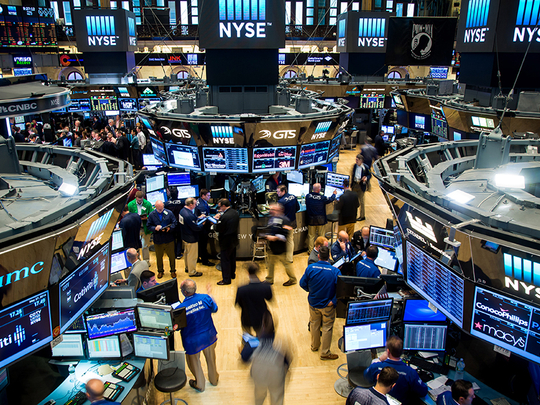
New York: Here’s a twist: US stock investors aren’t melting down at the thought of a Federal Reserve interest rate increase.
The S&P 500 Index rose 2.3 per cent for its best week since March 4 as economic data from housing to jobless claims eased concerns that growth is too anaemic to withstand higher rates. The gain sent the index to a five-week high, erasing losses sparked by increasing anxiety that the Fed stands ready to tighten as soon as June, even as corporate profits remain mired in a yearlong slump.
Helping push the benchmark gauge to its second straight weekly advance was a resurgence in the two biggest industries in the stock market. Technology and financial shares jumped at least 2.6 per cent as all 10 groups in the S&P 500 advanced for the first time since March.
“Investors are checking the pulse of the economy and the numbers that came out this week indicate the economy can handle the stress of higher rates,” Jim Davis, regional investment manager for The Private Client Group of US Bank, said by phone. “It’s been a good week with all sectors rising and the economy is on good footing. It’s healthy.”
The S&P 500 jumped to 2,099.06 in the five days, leaving it 0.2 per cent below its level on April 20 level, when it reached the year’s high. The Dow Jones Industrial Average climbed 372.28 points, or 2.1 per cent, to 17,873.22. US markets are closed on Monday for the Memorial Day holiday.
After roughly two years in which speculation over the Fed’s interest rate path routinely whipsawed equity markets, investors are showing signs of getting comfortable with the second quarter-point increase in rates since the central bank cut them to near zero eight years ago.
An rally of more than 85 per cent in crude that took prices above $50 for the first time since November and signs of resilience in the American economy pushed the S&P 500 within 1.5 per cent of its all-time high, a level it hasn’t breached in more than a year. The central-bank stimulus has underpinned the seven-year equity bull market that is now the second-longest in history.
The latest week’s biggest surprise in economic data came Tuesday, when new home sales in April surged 17 per cent to the highest level since the start of 2008. Jobless claims followed suit, as initial applications for unemployment fell for a second week. Data on Friday showed the US economy expanded at a slightly faster pace in the first quarter than previously estimated.
The data assuaged concerns that arose after lacklustre first-quarter results from American retailers fostered doubts about the strength of consumers at the same time that hawkish Fed meeting minutes and commentary from officials signaled a rate hike could be warranted in June.
The minutes released May 18 sent expectations for a June increase soaring to past 30 per cent from near zero, with the chances of a move in July moving past 50 per cent. Fed Chair Janet Yellen echoed the hawkish sentiment on Friday in a discussion at Harvard University in Massachusetts. Her comments added to bets, moving the July odds toward 60 per cent.
For more on Yellen’s latest comments on monetary policy, click here.
“It’s really clear we’re not going into recession – we’re probably not growing very fast, but we’re growing fast enough to keep us out of recession,” said Tim Courtney, chief investment officer of Exencial Wealth Advisors, which oversees $1.5 billion in assets in Oklahoma City. “Markets were getting really soft and some of the weaker areas of the market were sagging and were not doing as well and that’s generally a weak sign. This week, that reversed.”
Advances in equities were widespread, with all 10 groups posting gains – the first market-wide advance since the week ended March 11. US stocks were not alone, as the MSCI All-Country World Index added 2.2 per cent, as markets in Europe and Asia climbed.
Technology and financial stocks, which together make up 36 per cent of the S&P 500, rallied at least 2.6 per cent in the week, the first time this year that the two biggest groups in the market also posted the two biggest gains.
Surges of at least 12 per cent in four tech companies helped push that group to its best week since February. Hewlett Packard Enterprise Co., HP Inc., Micron Technology Inc. and Western Digital Corp. led the gains, as only three stocks in the 68-member group fell.
Financial firms in the index jumped 2.6 per cent to the highest level of the year, as the prospect of higher interest rates fueled speculation bank profits may benefit. Legg Mason Inc. and Invesco Ltd. rose more than 6 per cent.












